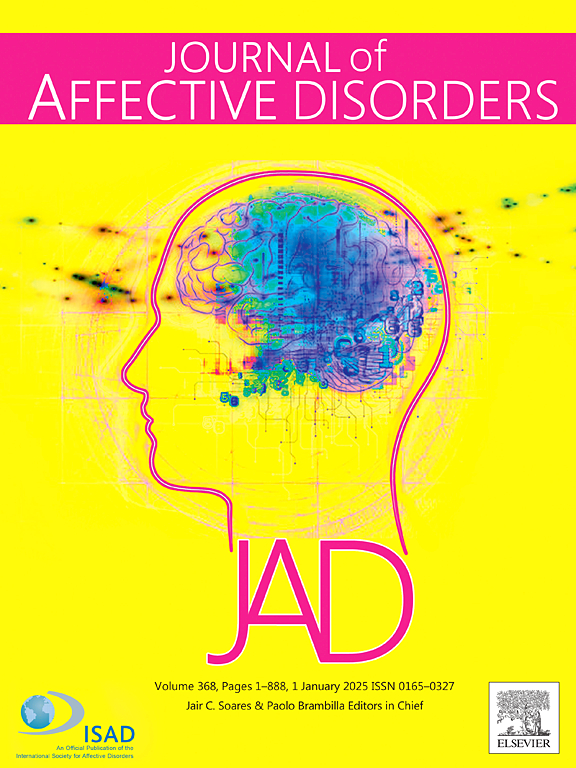Longitudinal network structures in PTSD treatment outcomes: Implications for tailored treatment
IF 4.9
2区 医学
Q1 CLINICAL NEUROLOGY
引用次数: 0
Abstract
Post-traumatic Stress Disorder (PTSD) is a debilitating condition disproportionately affecting military populations. Despite wide-spread availability of trauma-focused treatments like Cognitive Processing Therapy (CPT) and Prolonged Exposure Therapy (PE), many patients continue to experience PTSD symptoms post-treatment. This study employed network analyses to investigate variations in PTSD symptom networks between treatment responders and non-responders. The sample comprised 1902 service members and veterans who completed a two-week intensive PTSD treatment program (CPT or PE). The PTSD Checklist for DSM-5 assessed baseline and post-treatment PTSD severity. Most participants were male (80.27 %), White (76.17 %), veterans (76.37 %), and previously deployed (90.13 %). We compared networks across groups at baseline and within groups over treatment. Participants reported significant declines in PTSD severity over time (t[11901] = 1238.13, p < 0.001), with 28.23 % (n = 537) classified as responders based on a reliable change index. Responders had significantly higher baseline PTSD severity than non-responders (t([11,393.9] = −14.29, p < 0.001). Network comparison tests revealed a higher global strength among non-responders at baseline. Network structure and connectivity remained stable from baseline to post-treatment, suggesting limited reorganization of symptom relationships during the initial two-week treatment phase. Slope analysis revealed lower network connectivity among responders, indicating a loosening symptom interrelations potentially linked to greater symptom independence or reduced mutual reinforcement. A reduction in global strength and significant structural differences were identified between post-treatment and 12-month follow-up networks. Reductions in central symptoms identified in slope network might serve a key role in monitoring treatment response. Follow-up network revealed structural changes that might reflect skill application after treatment.
PTSD治疗结果的纵向网络结构:对量身定制治疗的影响
创伤后应激障碍(PTSD)是一种严重影响军人的衰弱性疾病。尽管认知处理疗法(CPT)和长期暴露疗法(PE)等以创伤为重点的治疗方法广泛应用,但许多患者在治疗后仍会出现创伤后应激障碍症状。本研究采用网络分析探讨治疗反应者与无反应者之间PTSD症状网络的差异。样本包括1902名服役人员和退伍军人,他们完成了为期两周的PTSD强化治疗项目(CPT或PE)。DSM-5的PTSD检查表评估了基线和治疗后PTSD的严重程度。大多数参与者是男性(80.27%),白人(76.17%),退伍军人(76.37%)和以前的部署(90.13%)。我们比较了基线组间和治疗组内的网络。受试者报告PTSD严重程度随时间显著下降(t[11901] = 1238.13, p <;0.001),其中28.23% (n = 537)根据可靠的变化指数归类为应答者。有反应者的基线PTSD严重程度显著高于无反应者(t([11,393.9] = - 14.29, p <;0.001)。网络比较测试显示,基线时无反应者的整体强度更高。从基线到治疗后,网络结构和连通性保持稳定,表明在最初的两周治疗阶段,症状关系的重组有限。斜率分析显示,应答者之间的网络连通性较低,表明症状相互关系的松动可能与更大的症状独立性或相互强化的减少有关。在治疗后和12个月的随访网络之间发现了总体强度的降低和显著的结构差异。在斜坡网络中发现的中心症状的减少可能在监测治疗反应中起关键作用。随访网络显示结构变化可能反映治疗后的技能应用。
本文章由计算机程序翻译,如有差异,请以英文原文为准。
求助全文
约1分钟内获得全文
求助全文
来源期刊

Journal of affective disorders
医学-精神病学
CiteScore
10.90
自引率
6.10%
发文量
1319
审稿时长
9.3 weeks
期刊介绍:
The Journal of Affective Disorders publishes papers concerned with affective disorders in the widest sense: depression, mania, mood spectrum, emotions and personality, anxiety and stress. It is interdisciplinary and aims to bring together different approaches for a diverse readership. Top quality papers will be accepted dealing with any aspect of affective disorders, including neuroimaging, cognitive neurosciences, genetics, molecular biology, experimental and clinical neurosciences, pharmacology, neuroimmunoendocrinology, intervention and treatment trials.
 求助内容:
求助内容: 应助结果提醒方式:
应助结果提醒方式:


